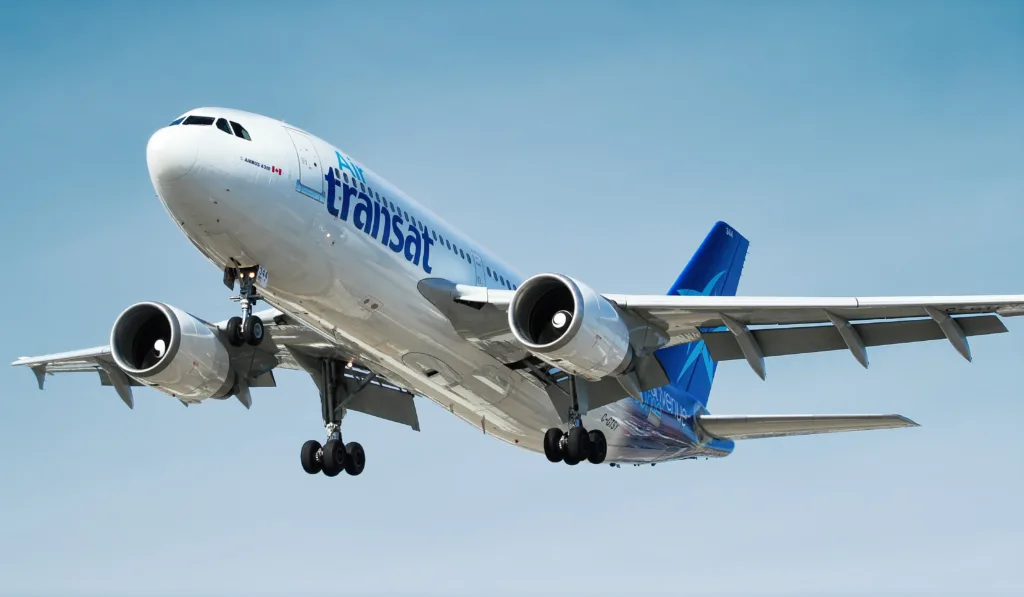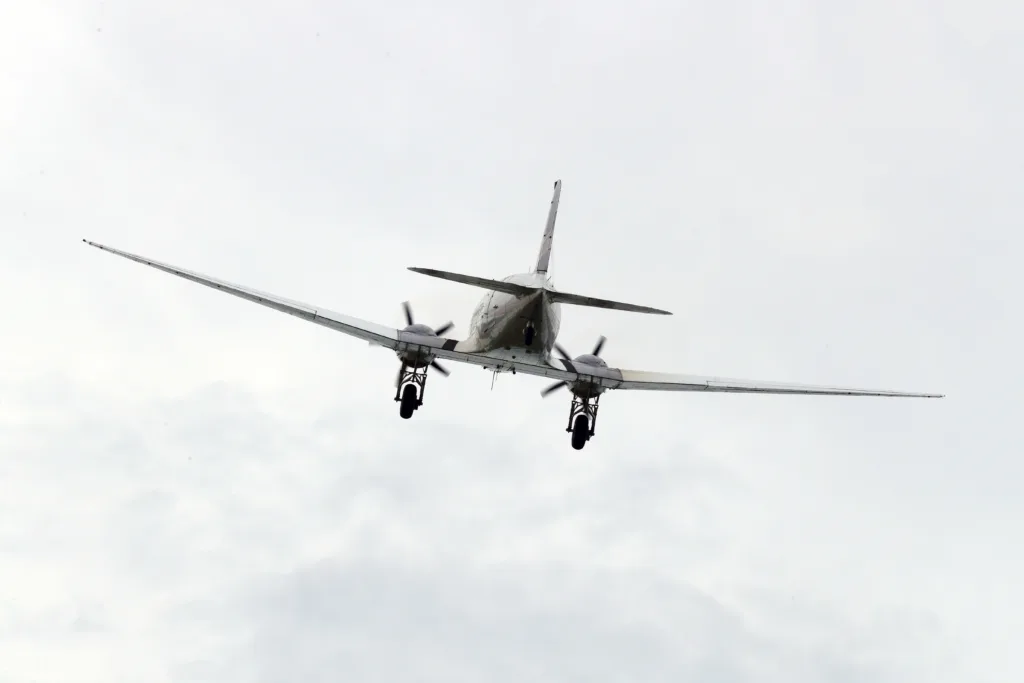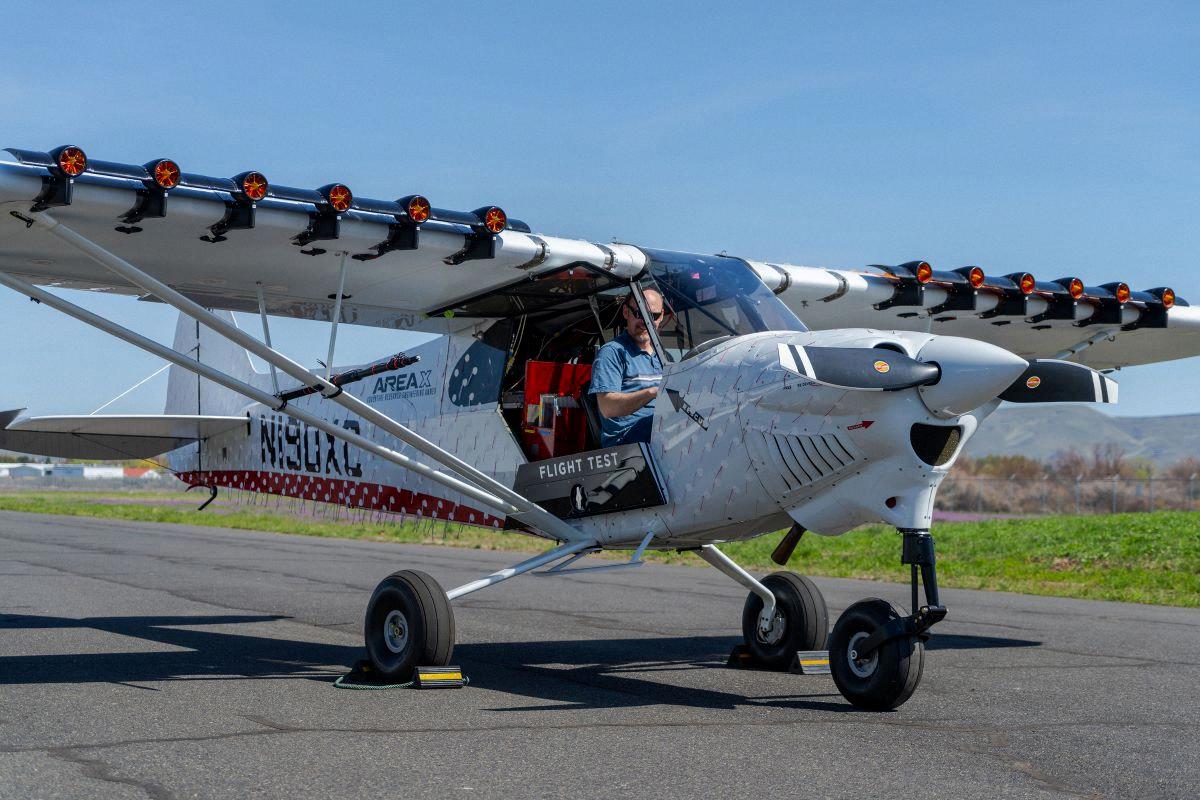Slats are an essential component of the wings on certain fixed-wing aircraft, designed to enhance lift during low-speed operations such as takeoff, initial climb, approach, and landing. These extendable, high-lift devices are located on the leading edge of the wings and play a crucial role in the aircraft’s performance.
There are three main types of slats: fixed, automatic, and powered. Fixed slats, also known as slots, are stationary and create a gap or slot between the slat and the wing. This design helps to improve lift by allowing air to flow smoothly over the wing’s surface.
Automatic slats, on the other hand, are movable and deploy automatically based on the angle of attack. They extend outwards from the wing’s leading edge when needed and retract when not in use. This automatic deployment ensures optimal lift during different phases of flight without requiring direct pilot input.
Powered slats, as the name suggests, are controlled by a power source such as hydraulic or electric systems. These slats can be operated by the pilot, allowing for precise control over their deployment and retraction. Powered slats offer flexibility and adaptability in various flight conditions.
The primary purpose of slats is to increase lift at low speeds. During takeoff and landing, when the aircraft is flying at a relatively low airspeed, slats are crucial in generating enough lift to support the aircraft’s weight and ensure a safe and smooth operation. By extending the slats, the wing’s camber is increased, allowing for a higher angle of attack and improved lift characteristics.
Slats are particularly effective near the wingtips, where the wing’s surface area is reduced. By adding slats to the outboard section of the wing, designers can counteract the decrease in lift caused by the reduced wing area. This helps to maintain lift and prevent stalling, even at lower airspeeds.
It’s important to note that slats do come with some drawbacks. As an additional high-lift device, they do create additional drag, which can affect the aircraft’s overall performance. However, the benefits of increased lift and improved safety during critical phases of flight outweigh the drag considerations.
Slats are an integral part of certain aircraft’s wing design, providing increased lift during low-speed operations. They come in different types, including fixed, automatic, and powered, each with its own advantages and applications. Slats work in tandem with other high-lift devices, such as trailing-edge flaps, to optimize the wing’s performance and ensure safe and efficient flight.
What Is The Purpose Of Slats?
Slats serve a crucial purpose in enhancing the performance of fixed wing aircraft during low speed operations such as takeoff, initial climb, approach, and landing. Their primary function is to increase lift, which is essential for safe and efficient flight.
Here are some key points explaining the purpose of slats:
1. Increase Lift: Slats are located on the leading edge of the wings and can be extended or retracted. When extended, they create a gap between the slat and the wing, allowing air to flow through. This airflow modification generates additional lift by increasing the curvature of the wing and delaying the onset of stall. By increasing lift, slats enable the aircraft to maintain stable flight at lower speeds.
2. Improve Control: Slats also play a role in improving the aircraft’s control during low speed operations. By increasing lift, they help to reduce the stall speed, allowing the pilot to maintain better control over the aircraft. This is particularly crucial during takeoff and landing, where precise control is necessary for a safe touchdown or climb.
3. Enhance Maneuverability: With the extended slats, the wings produce more lift, which enhances the aircraft’s maneuverability at lower speeds. This is especially important during approach and landing, where the aircraft needs to make precise turns and adjustments in order to align with the runway and touch down safely.
4. Shorten Takeoff and Landing Distances: By increasing lift and reducing stall speed, slats enable the aircraft to take off and land at lower speeds. This results in shorter takeoff and landing distances, which is particularly beneficial in situations where runways are limited in length, such as in smaller airports or aircraft carriers.
Slats are extendable, high lift devices located on the leading edge of the wings. They increase lift, improve control, enhance maneuverability, and shorten takeoff and landing distances during low speed operations, ultimately ensuring safe and efficient flight for fixed wing aircraft.

What Are The Types Of Slats?
There are three main types of slats: fixed slats, automatic slats, and powered slats. Here is a breakdown of each type:
1. Fixed slats: Also known as static slats, fixed slats are stationary and do not move or adjust. They are commonly used in various applications such as window blinds, fences, and aircraft wings. Fixed slats provide a simple and cost-effective solution for controlling light, airflow, and privacy.
2. Automatic slats: Automatic slats, also called self-adjusting or dynamic slats, have the ability to adjust their position automatically based on external factors. These slats are typically found in window blinds and shutters. They can be programmed to open or close in response to changes in sunlight, temperature, or time of day. Automatic slats offer convenience and energy efficiency by optimizing natural light and temperature control.
3. Powered slats: Powered slats are similar to automatic slats but are operated by a motor or mechanism. These slats can be controlled remotely via a switch, remote control, or even through smart home systems. Powered slats are commonly used in window treatments, such as motorized blinds or curtains, providing convenience and ease of use for adjusting light levels and privacy.
The three types of slats are fixed slats, automatic slats, and powered slats. Fixed slats are stationary, automatic slats adjust automatically, and powered slats are operated by a motor or mechanism. Each type has its own advantages and applications in various industries.
Do All Planes Have Slats?
Not all planes have slats. Slats are a type of high-lift device that are commonly used on high-speed turbojet aircraft. They are located on the leading edge of the wing and are responsible for increasing lift during takeoff and landing.
While slats are widely used in aviation, not all planes are equipped with them. The presence of slats depends on the design and purpose of the aircraft. Some aircraft, especially those designed for high-speed flight, may not require slats due to their aerodynamic characteristics and advanced wing designs. On the other hand, many commercial airliners and smaller aircraft do have slats as they help enhance low-speed performance and improve safety during critical phases of flight.
It is important to note that slats are not the only type of high-lift device used on aircraft. Another common type is the trailing edge flap system, which runs along the trailing edge of the wing. Flaps are found on almost all aircraft, regardless of their size or type. They are used to increase the wing area and change the wing’s camber, resulting in increased lift and improved control at slower speeds.
To summarize, while not all planes have slats, trailing edge flap systems running along the trailing edge of the wing are common on all aircraft. The presence of slats depends on the specific design and purpose of the aircraft, with some planes benefiting from their use in high-speed flight, while others rely on trailing edge flaps for improved performance at slower speeds.
How Do Slats And Slots Work?
Slats and slots are aerodynamic devices used in aircraft wings to enhance lift and improve the overall performance of the aircraft. They work by manipulating the airflow over the wing, allowing the aircraft to fly at lower airspeeds without stalling.
Slats are movable surfaces located on the leading edge of the wing. When deployed, they create a gap or slot between the slat and the wing surface. This gap serves to redirect the airflow, causing it to move downwards over the wing. By diverting the airflow in this manner, the slats increase the wing’s effective angle of attack. The angle of attack refers to the angle between the wing’s chord line (a straight line connecting the leading and trailing edges of the wing) and the oncoming airflow.
By increasing the angle of attack, the slats enable the wing to generate more lift at lower airspeeds. This is particularly crucial during takeoff and landing when the aircraft needs to maintain lift at lower speeds. Without slats, the wing would stall at higher angles of attack and slower airspeeds, leading to a loss of lift and potentially causing the aircraft to lose control.
Slots, on the other hand, are narrow openings or gaps located on the upper surface of the wing, just behind the leading edge. These slots also serve to redirect the airflow. When the aircraft is flying at high angles of attack, the airflow passing through the slot is also redirected downwards over the wing. This helps to delay the stall by preventing the airflow separation over the upper surface of the wing.
Slats and slots work together to enhance the wing’s lift and allow the aircraft to fly at lower airspeeds without stalling. They redirect the airflow downwards, increasing the wing’s effective angle of attack and enabling it to generate more lift. Slats are located on the leading edge of the wing, while slots are openings on the upper surface of the wing. These aerodynamic devices play a vital role in the safe and efficient operation of aircraft during takeoff, landing, and other critical flight phases.

What Are Slats And Flaps In Aircraft?
Slats and flaps are important components of an aircraft’s wings that play a crucial role in improving its performance during takeoff, landing, and low-speed flight.
Slats are located on the leading edge of the wing and are designed to increase the wing area. They are movable surfaces that can be extended or retracted. When the slats are extended, they create a slot between the wing and the slat, which allows air to flow smoothly over the wing and generate more lift. This helps the aircraft to maintain lift at lower speeds, such as during takeoff and landing. With the slats retracted, the wing operates more efficiently at higher speeds.
Flaps, on the other hand, are located on the trailing edge of the wing and are also movable surfaces. They work by increasing the wing’s surface area and changing its shape. By extending the flaps, the curvature of the wing is increased, which generates more lift at lower speeds. This enables the aircraft to take off and land at slower speeds and shorter distances. Additionally, the increased lift provided by the flaps allows the aircraft to maintain control at lower speeds, which is particularly important during approach and landing.
In summary:
Slats:
– Located on the leading edge of the wing.
– Increase wing area.
– Can be extended or retracted.
– Create a slot between the wing and the slat when extended.
– Improve lift generation at lower speeds.
– Used during takeoff and landing.
Flaps:
– Located on the trailing edge of the wing.
– Increase wing surface area.
– Can be extended or retracted.
– Change the shape of the wing.
– Generate more lift at lower speeds.
– Enable slower takeoff and landing speeds.
– Enhance control during approach and landing.
Both slats and flaps are crucial in ensuring the safe and efficient operation of an aircraft during different phases of flight. Their ability to modify the wing’s characteristics allows pilots to adapt to varying flight conditions, ensuring optimal performance and maneuverability.

What Is The Purpose Of A Slat On An Aerofoil?
The purpose of a slat on an aerofoil, specifically on the leading edge of an airplane’s wing, is to enhance the wing’s lift-producing capabilities during low airspeeds and high angles of attack. Slats are a type of high-lift device, functioning similarly to trailing-edge flaps. They play a crucial role in improving the aircraft’s overall performance, particularly during takeoff and landing procedures.
Here are a few key points to further explain the purpose of slats on an aerofoil:
1. Increasing lift: Slats work by modifying the shape of the wing, specifically the camber or curvature. By moving forward, slats effectively increase the wing’s camber, resulting in a higher lift coefficient. This increased lift enables the aircraft to generate more lift at slower speeds, allowing for safer and more efficient takeoffs and landings.
2. Delaying stall: Stall refers to the loss of lift that occurs when the airflow over the wing separates, usually due to excessive angle of attack (AOA). Slats help in delaying the stall by maintaining a smooth and attached airflow over the wing surface, even at higher angles of attack. This improves the aircraft’s controllability and maneuverability, especially during critical flight phases.
3. Enhancing control: Slats also contribute to improving the aircraft’s control characteristics. By increasing the camber and lift on the leading edge of the wing, slats help to maintain a balanced lift distribution across the wing, reducing the chances of asymmetric stall or loss of control. This enhances the pilot’s ability to handle the aircraft during various flight conditions.
The purpose of a slat on an aerofoil is to enhance lift and control during low airspeeds and high angles of attack. By modifying the wing’s shape and delaying stall, slats play a vital role in improving the aircraft’s performance during takeoff, landing, and other critical flight phases.
What Are The Purposes Of A Winglet?
Winglets serve multiple purposes in the field of aviation. They are vertical extensions attached to the wingtips of an aircraft, designed to enhance its fuel efficiency and cruising range. These small airfoils are specifically engineered to reduce the aerodynamic drag caused by vortices that form at the wingtips as the airplane moves through the air.
Here are the key purposes of winglets:
1. Drag Reduction: Winglets help decrease the drag created by the vortices that occur at the wingtips. By minimizing this drag, winglets allow the aircraft to maintain a higher speed while consuming less fuel. This improved aerodynamic efficiency ultimately leads to reduced operating costs for airlines.
2. Increased Lift: Winglets also contribute to increasing the overall lift generated by the wings. They effectively reshape the wingtip vortices, resulting in a more efficient lift distribution across the wing. This additional lift allows the aircraft to fly at a lower angle of attack, which further reduces drag and improves fuel efficiency.
3. Improved Stability and Control: Winglets help enhance the aircraft’s stability and control characteristics. They assist in reducing the tendency for the aircraft to roll or yaw, providing a more balanced and stable flight experience. This improved stability also contributes to the safety and comfort of passengers and crew.
4. Extended Range: By reducing drag and improving fuel efficiency, winglets enable aircraft to fly longer distances without the need for additional fuel stops. This extended range capability is particularly beneficial for long-haul flights, allowing airlines to reach more destinations without sacrificing payload capacity.
5. Environmental Impact: The fuel efficiency gains achieved through winglets have a positive environmental impact. By reducing fuel consumption, winglets help decrease greenhouse gas emissions and overall carbon footprint. This aligns with the aviation industry’s ongoing efforts to reduce its environmental impact and promote sustainability.
Winglets serve the purpose of reducing aerodynamic drag, increasing lift, improving stability and control, extending the aircraft’s range, and reducing environmental impact. These small yet significant enhancements contribute to more efficient and economical flight operations in the aviation industry.
Do Flaps And Slats Work Together?
Flaps and slats work together to enhance the performance of an aircraft during takeoff and landing. Flaps are hinged surfaces located on the trailing edge of the wing, while slats are movable surfaces positioned on the leading edge of the wing.
When deployed, flaps and slats increase the surface area of the wing, which leads to an increase in lift. This is particularly important during takeoff and landing when the aircraft needs to generate more lift at lower speeds. By increasing the wing area, flaps and slats allow the aircraft to maintain lift at slower speeds, enabling a safer takeoff and landing.
Flaps and slats also have different configurations depending on the flight phase. During takeoff, they are typically extended partially to increase lift while minimizing drag. This configuration helps the aircraft to achieve a shorter takeoff distance.
On the other hand, during landing, flaps and slats are usually extended fully to maximize lift and increase drag. By increasing drag, the aircraft can slow down more effectively, allowing for a safer and smoother landing.
The combination of flaps and slats working together enhances the aerodynamic performance of the aircraft, allowing for better control at lower speeds during critical phases of flight.
Key points to remember are:
– Flaps and slats work together to increase the surface area of the wing and enhance lift.
– They are deployed during takeoff and landing to improve performance at lower speeds.
– Flaps and slats have different configurations depending on the flight phase, with partial extension during takeoff and full extension during landing.
– The increased lift and drag provided by flaps and slats contribute to safer takeoffs and landings.
Conclusion
Slats are extendable, high lift devices located on the leading edge of aircraft wings. Their primary function is to increase lift during low speed operations such as takeoff, climb, approach, and landing. Slats come in three types: fixed, automatic, and powered. They are designed to alter the shape of the wing and increase its camber, allowing the aircraft to operate at higher angles of attack and lower airspeeds without stalling. Slats work in conjunction with trailing edge flaps to increase the surface area of the wing and generate more lift. This is especially important during landing, as both slats and flaps angle down to maximize wind capture and slow down the aircraft with drag. Slats, along with winglets on the wingtips, play a crucial role in improving an aircraft’s fuel efficiency, cruising range, and overall aerodynamic performance.
